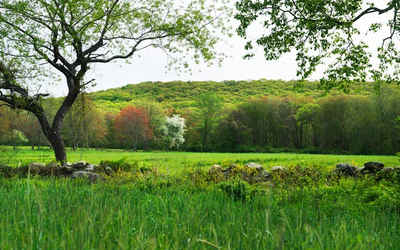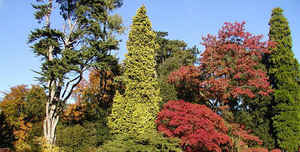Rhode Island State Tree
Red Maple

(Aceraceae Acer rubrum)
Adopted on March 6, 1964.
The Red Maple, (Aceraceae Acer rubrum,) , also known as the Swamp Maple or Soft Maple, was voted as the state tree by school children in the 1890's. But it wasn't officially adopted as the state tree until March 6, 1964. In the fall, the leaves turn gold, purple, and scarlet, adding to the beauty of Rhode Island's forests.
Rhode Island State Tree: Red Maple

The Red Maple is widely planted as an ornamental tree in public park settings, along streets, and in private yards throughout North America. It is relatively easy to cultivate from seed and grows very rapidly once established.
Red Maple wood is somewhat soft. It is commonly used in products like clothespins, veneer, interior moldings, and inexpensive furniture. The tree produces high quality sugar, but its yield pales in comparison to the Sugar Maple and Black Maple due primarily to the fact that it begins growth much earlier in the season resulting in a shorter sugar collection period. In past times, tannin was extracted from Red Maple trees for clothing dye and ink production.
Common names
Red maple is also known as scarlet maple, swamp maple, soft maple, Carolina red maple, Drummond red maple, and water maple.
Identification of the Red Maple

Many foresters consider the tree inferior and undesirable because it is often poorly formed and defective, especially on poor sites. On good sites, however, it may grow fast with good form and quality for saw logs. Red maple is a subclimax species that can occupy over story space but is usually replaced by other species. It is classed as shade tolerant and as a prolific sprouter. It has great ecological amplitude from sea level to about 900 m (3,000 ft) and grows over a wide range of microhabitat sites. It ranks high as a shade tree for landscapes.
- Leaf: Opposite, 3 to 5 palmate lobes with serrate margins, sinuses relatively shallow (but variable), 2 to 4 inches long; light green above, whitened and sometimes glaucous or hairy beneath.
- Flower: Appear March to May, usually before leaves; usually bright red but occasionally yellow.
- Fruit: Clusters of 1/2 to 3/4 inch long fruit with slighly divergent wings, appear May to June, on long slender stems. Light brown and often reddish.
- Twig: Reddish and lustrous with small lenticels, buds usually blunt, green or reddish (fall and winter) with several scales usually present, leaf scars V-shaped, 3 bundle scars, lateral buds slightly stalked, may be collateral buds present.
- Bark: On young trees, smooth and light gray, with age becomes darker and breaks up into long scaly plates.
- Form: Medium-sized tree. In forest, trunk usually clear for some distance, in the open the trunk is shorter and the crown rounded.
Rhode Island Laws
The law designating the red maple as the official Rhode Island state tree is found in the Rhode Island General Laws, Title 42 (State Affairs and Government) Chapter 4 (State Emblems) Section Section 42-4-8.
TITLE 42
State Affairs and Government
CHAPTER 42-4
State Emblems
SECTION 42-4-8
§ 42-4-8 State tree. - The tree commonly known as the "red maple" (acer rubrum) is hereby designated as the state tree.
History of Section.
(G.L. 1956, § 42-4-8; P.L. 1964, ch. 13, § 1.)
Taxonomic Hierarchy: Red Maple
Kingdom: Plantae - Plants
Subkingdom: Tracheobionta - Vascular plants
Superdivision: Spermatophyta - Seed plants
Division: Magnoliophyta - Flowering plants
Class: Magnoliopsida - Dicotyledons
Subclass: Rosidae
Order: Sapindales
Family: Aceraceae - Maple family
Genus: Acer L. - maple
Species: Acer rubrum L. --red maple








